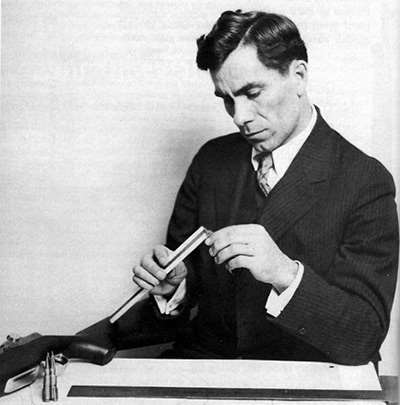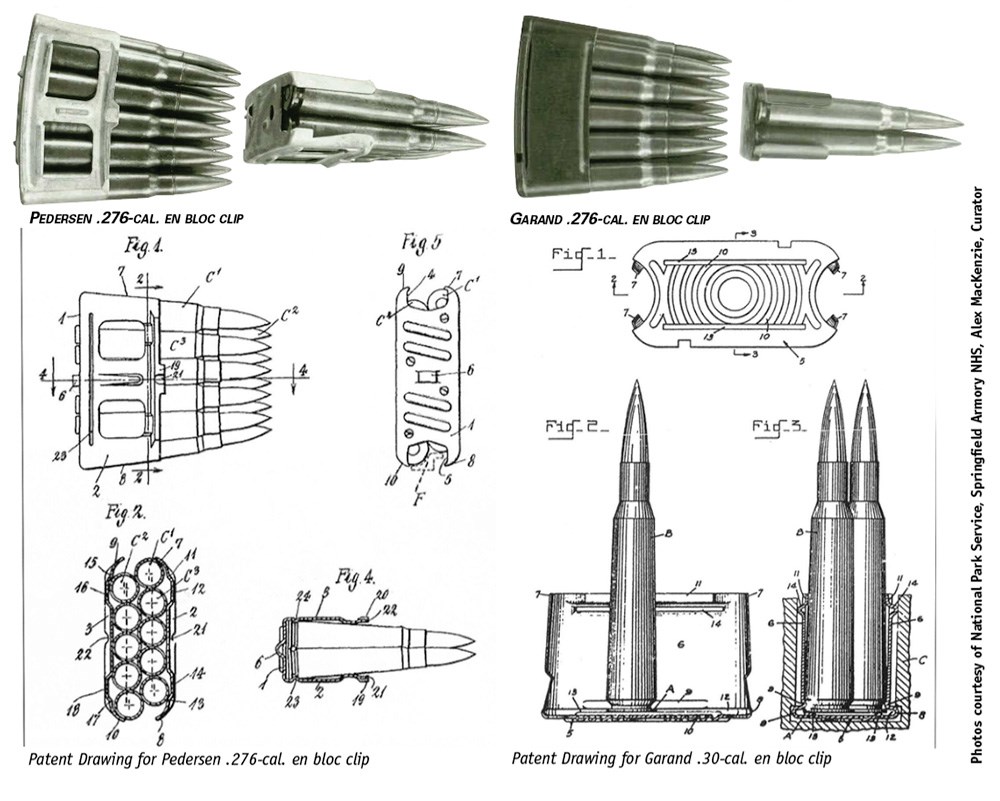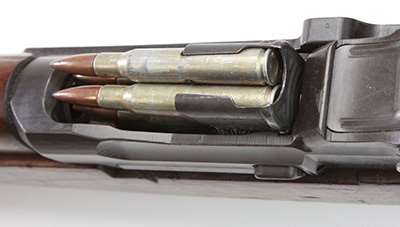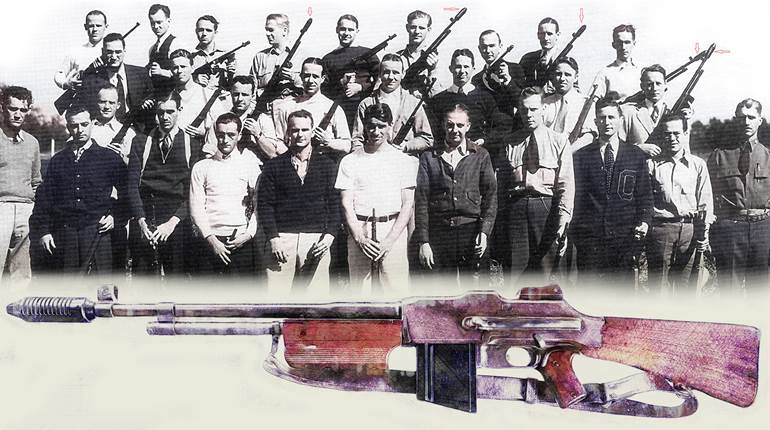
One of the best-known and most-respected U.S. military service rifles of all time is the “U.S. Rifle, Caliber .30, M1,” popularly known as the “Garand” after its inventor, John C. Garand. The M1 was the primary American service rifle during World War II and the Korean War and garnered an enviable reputation for its performance on countless battlefields around the globe. Like any firearm, however, the M1 was not above criticism. The two most frequently cited complaints against the Garand rifle was its weight of almost 10 lbs. and its clip-loading mechanism. The M1 utilized a sheet metal clip that held eight rounds of .30 Springfield (.30-’06 Sprg.) ammunition. The clip was inserted into the top of the receiver, and the bolt closed when the clip was fully seated. After the last round was fired, the clip was automatically ejected with a distinctive metallic “ping” sound. As discussed by author Roy Dunlap, who served in an Army ordnance outfit during World War II:

“The Garand has two faults, to my mind—it is too heavy and it must be loaded with the eight-round charger clip. The latter means you either load it with a full eight-round clip or you have one of the clumsiest single shot arms since muzzle-loading days ... If, say five cartridges in a clip are fired, three remain in the gun, and the five expended ones are well-nigh impossible to replace in the rifle. Perhaps only one cartridge remains to fire; the rifle is a single shot until the cartridge is fired and a full clip loaded to replace it. In action, soldiers simply released and ejected partially-emptied clips and reloaded with full ones in an attempt to keep full effectiveness as long as they could. In some outfits it was customary to empty the rifle—blazing away the remaining cartridges … it is of course easier and faster to empty the rifle by firing than by stopping to use two hands to hold the bolt back and press the clip release.”
It is sometimes claimed that the “ping” sound of the ejected clip was a serious problem because it alerted the enemy that the soldier now had an empty rifle and was vulnerable to attack. It has been stated in some publications and faux history television programs that numerous American soldiers were killed because of the telltale Garand “ping,” but there is no documented evidence that even one casualty was inflicted because of the sound, and the entire scenario is highly implausible. There are valid reasons to criticize the M1 rifle, but the sound of its clip being ejected is not among them. Nevertheless, John Garand has been excoriated from time to time during the past 80-plus years for using this type of feeding mechanism, and the disapproval continues to be raised even today. An illustrative example was voiced by a British writer who expressed the following:
“The most frequent criticism of the Garand is leveled at its magazine and method of loading. Here it does seem that J. Garand missed an opportunity and one wonders why. It is just possible that he was concerned about weight, for the empty rifle weighs 9½ pounds, or he may not have wished to fit a vulnerable sheet metal box which projected below the smooth outline of the stock. Whatever the reason, he was perhaps wrong, and it is a pity that the U.S. Army did not ask for the magazine to be changed when they accepted the weapon … . This was an unusual way of doing it, and it was not universally praised for various minor reasons, one of which was the fact that a magazine could not be ‘topped up,’ it was a complete clip or nothing.”
Indeed, it is logical to ask why John Garand didn’t utilize a detachable box magazine for his rifle. After all, the venerable Model 1918 Browning Automatic Rifle was developed years before the M1 rifle and utilized a 20-round detachable box magazine that functioned quite well. Why didn’t Garand take a page from Browning and use a similar magazine for his semi-automatic rifle? It may surprise many, but that is exactly what Garand intended to do.
To digress a bit, John Garand had developed an automatic rifle with an unusual primer-actuated mechanism near the conclusion of the First World War. The Army already had the magnificent BAR and wasn’t interested in another automatic rifle. However, Garand’s talents were recognized by the Ordnance Dept., and he was hired in 1919 as a gun designer at Springfield Armory to work on the semi-automatic rifle development program that was being carried on at the Armory. Garand’s first semi-automatic prototype was a modified version of the automatic rifle he had previously designed. Designated as the “T1919,” the firearm had a 20-round detachable box magazine very similar to that of the Model 1918 BAR. In 1920, he developed his second semi-automatic rifle prototype, the “T1920,” that was similar to the T1919 but incorporated a number of improvements. Detachable box magazines with varying capacities (up to 40 rounds) were fabricated for the arm. Clearly, John Garand favored the detachable box magazine since that was the type his first two prototype rifles were designed to use. So, what happened?
By May 1920, the Ordnance Dept. was evaluating several types of semi-automatic rifles, including the T1920 Garand, at Springfield. In order to bring some conformity to the evaluation process, on Feb. 1, 1921, the Ordnance Board prepared a detailed list of requirements for any semi-automatic submitted for evaluation. One of the requirements stated:
“The rifle must be designed that the magazine while in position in the rifle may be fed from clips. The magazine may be detachable, but this is not considered desirable … The capacity of the magazine should not exceed ten rounds.” (Bold type added for emphasis)
Clearly, the Ordnance Dept. wasn’t a fan of the detachable magazine for the proposed semi-automatic service rifle. This wasn’t lost on John Garand. He revised his T1920 prototype to incorporate an internal magazine rather than the detachable box magazine he initially favored for the rifle.

In November 1920, the War Dept. convened a board of officers to evaluate other semi-automatic rifles that had been submitted since the previous testing in May. It has been said, with some justification, that what Ordnance really wanted was a semi-automatic Model 1903, and the summary of the November test stated:
“In view of the broad publicity given to the tests of semiautomatic rifles just completed … the Board is of the opinion that the test demonstrates that the service U.S. Rifle M1903 remains supreme as the standard for troops, and is far superior to any semiautomatic rifle submitted to the Board.”
Aware of Ordnance’s conclusions, Garand developed a totally re-designed rifle that was markedly different from the T1920 prototype, although it still retained the primer-actuated mechanism. His new design, designated as the T1921, or Model 1921, utilized an integral magazine like the Model 1903, and the overall configuration resembled the ’03 much more than did his previous T1919 or T1920 rifles—and even shared some common components such as barrel bands and other furniture.
The new Model 1921 Garand rifle was tested in June 1922 and sufficiently impressed the Ordnance Board to schedule additional tests against other semi-automatic rifles that had been submitted. Garand made some minor changes in the design, most notably a new type of rear sight, and the revised design was designated as the “Model 1924.”
While the Ordnance Dept. was in the process of evaluating Garand’s latest design, as well as other rifles submitted for testing, it was decided to seek input from additional gun designers. One such individual was John D. Pedersen who, with the exception of the legendary John Moses Browning, was perhaps the most famous gun designer in the country, if not the world. Pedersen made a strong case to Ordnance that the current .30-’06 Sprg. cartridge was unnecessarily powerful and was part of the reason why efforts to develop a successful semi-automatic rifle had thus far been elusive. He stated that a .276-cal. cartridge would be powerful enough for the average infantry engagement and would result in a lighter rifle, lighter ammunition and less propensity for overheating. Pedersen also touted the virtues of what he called the “en bloc” clip (a term he apparently coined), which was inserted into the rifle and ejected when the final round was fired. While similar clips had been previously used in a few other rifles (primarily developed in other countries), Pedersen recognized the en bloc clip was an ingenious solution to address Ordnance’s preference for an internal magazine while permitting more rapid operation than was the case with the ’03 rifle’s charger-fed (stripper clip) internal magazine. Pedersen patented his proprietary en bloc clip design.
The .276-cal. Pedersen rifle (which featured an unusual toggle action) and its en bloc clip were clearly favored by a number of Ordnance Dept. officers, but John Garand’s Model 1924 .30-cal. primer-actuated rifle still had its supporters. Side-by-side comparative testing of the Pedersen and Garand rifles was desired so that the issue of which design should continue to be developed could be settled.
However, fate intervened and dealt Garand an unexpected blow when the standard .30-cal. cartridge was modified to more firmly crimp the primer in place. This resulted in rendering his signature primer-actuated mechanism useless, and six years of work went down the drain. Garand went, literally, back to the drawing board to design a semi-automatic rifle that featured a more conventional gas-operated system. He was not a fan of the 0.276" cartridge, and his new rifle continued to be chambered for the .30-’06 Sprg. cartridge. He was obviously well aware of Ordnance’s unmistakable preference for the en bloc clip, which he incorporated into the design of his new rifle, however, Garand designed his clip to have a solid body rather than the sectionalized body of the Pedersen clip. Also, the Garand clip was “ambidextrous,” as either end could be inserted, whereas the Pedersen clip could only be inserted one way. Due to the larger diameter of the .30-cal. cartridge as compared to the .276, the Garand clip had a capacity of eight rounds rather than the Pedersen clip’s 10. While not explicitly stated, it was likely that Garand was encouraged, if not directed, by Ordnance to make sufficient changes to his clip so as not to run afoul of any infringements of Pedersen’s patent.

In July 1926, the new .30-cal. gas-operated Garand rifle, designated as the “T1,” was ready for preliminary testing. The Ordnance Committee determined the gun had some “interesting characteristics but was of the wrong caliber” and only a single prototype of the .30-cal. Garand T1 was fabricated. Clearly, Ordnance was enthusiastic about the .276 cartridge and directed that Garand revise his new rifle to incorporate the reduced-caliber cartridge. This was easily accomplished, as he simply scaled-down the .30-cal. T1 to accommodate the 0.276" round. While the en bloc clip for the .276 Garand rifle had the same basic configuration as the .30-cal. T1 clip, like the Pedersen clip, it had a 10-round capacity. The revised Garand rifle was designated as the “T3” and was subsequently followed by the slightly improved “T3E1” and “T3E2” rifles. Springfield Armory manufactured sufficient numbers of .276 Pedersen and Garand rifles for extensive testing.
John Pedersen was absolutely convinced that his rifle had a “lock” on being the new United States service rifle, but, after exhaustive testing, the Garand rifle was determined to be the better design, and Pedersen’s generous development contract was canceled. Pedersen was extremely unhappy with the turn of events and subsequently filed a patent infringement suit against the government for his en bloc clip. The government argued that the Garand clip design was sufficiently different from Pedersen’s so as not to constitute patent infringement. The litigation lingered on for several years before a court ruled in favor of the government; Pedersen, however, appealed the verdict and, in 1935, received a $40,000 settlement (almost $880,000 in inflation-adjusted dollars). The designs for the Garand and Pedersen rifles were markedly different so as to preclude any patent infringement claims by Pedersen, although he did try, unsuccessfully, several years later.

In January 1932, the .276-cal. T3E2 Garand was recommended for adoption as the United States’ first semi-automatic service rifle, but the recommendation was disapproved by Army Chief of Staff, Gen. Douglas MacArthur, primarily due to various concerns about the .276 cartridge. Also, millions of rounds of perfectly serviceable .30-cal. ammunition were in inventory, and spending money on a totally new cartridge in the midst of the Great Depression wouldn’t have gone over well with either Congress or the American public. Since the basic Garand rifle was deemed to be satisfactory, it was directed that a .30-cal. version should be developed. Fortunately, Garand had already done so with the T1 rifle he had designed five years earlier. Some additional refinements were made at Springfield Armory’s Model Shop, and the final prototype was designated “T1E2.” Eighty T1E2 rifles were fabricated and extensively tested with very satisfactory results. The T1E2 .30-cal. Garand rifle was standardized as the “U.S. Rifle, Semiautomatic, Caliber .30, M1” on Jan. 9, 1936. Soon after adoption, “Semiautomatic” was dropped from the nomenclature. As the old saying goes, “The rest is history.”
As can be seen, while the en bloc clip is a signature feature of the M1, criticisms leveled against Garand for using this design rather than a detachable box magazine are clearly misplaced. The en bloc clip was a fait accompli due to the Ordnance Dept.’s insistence that the new semi-automatic service rifle have an internal magazine and John Pedersen’s previous successful lobbying. John Garand knew the die was cast and his rifle must have the en bloc clip feature, regardless of whatever reservations he may have had. Garand’s preference for the .30-’06 Sprg. cartridge over the .276 eventually prevailed, but the en bloc clip trumped Garand’s initial predilection for the detachable box magazine.

The question must be asked as to why Ordnance was opposed to the detachable box magazine and favored an internal magazine in the first place. As alluded to, the Model 1903 Springfield bolt-action rifle was the darling of the Ordnance Dept. from the time of its adoption until well into the 1930s, and many senior officers were leery of a “new-fangled” semi-automatic, feeling that if the internal magazine was good enough for the ’03, it was good enough for a semi-automatic rifle. A less provincial and much sounder reason was that a detachable box magazine, especially with a 10-round or greater capacity, would prove to be too heavy. Other concerns were that the detachable box magazines were more expensive, potentially prone to damage and could be cumbersome when firing from the prone position. The en bloc clip negated all of these concerns. Would the M1 rifle have been better with a detachable magazine? Perhaps, but the M1’s stellar performance on the battlefield vividly illustrates that the en bloc clip did not unduly hamper the effectiveness of the firearm.
During World War II, John Garand developed a variant of the M1 rifle capable of selective-fire operation and fitted with a 20-round detachable magazine. In any event, an eight-round en bloc clip would hardly have been the optimum feeding mechanism for a selective-fire small arm. Garand continued working on a selective-fire, detachable-magazine rifle during the war, which culminated with the “T20E2” that would have likely superseded the M1 had the war lasted into 1946 or later, as was expected. With the coming of V-J Day, however, the selective-fire rifle project was shelved and resurrected in the 1950s. Subsequent efforts led to the adoption of the M14 rifle in 1957 that had the same basic type of detachable magazine as the World War II-era T20 series. Subsequent U.S. service rifles utilized the same type of magazine system, which proved that, even back in 1919, Garand was ahead of his time.




































